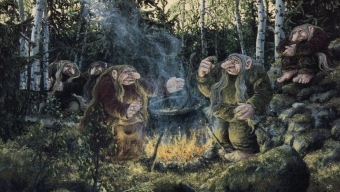Fairy Tales Are Healing To The Soul of a Child….
Fairy tales have an enormous and irreplaceable value in the life of a child. They educate, support and liberate the emotions of children. Fairy tales provide a unique way for children to come to terms with the dilemmas of their inner lives.
The prince, the tailor, the miller, snow white – all of these are images of different elements of our own nature. It is this resonance which endears these figures to us. There is a wisdom in these characters which runs much deeper than allegory or what can be found is psychoanalysis.
“In the art and fantasy of fairy tales lies a very deep wisdom which has power to awaken children from the sleep of ordinary life. Forces of healing are also hidden in each fairy tale. The most important effect of the fairy tale is that they stimulate the feeling that man is a being of development, of struggle, of metamorphosis, and that behind all the adverse forces of giants and dwarfs, witches and demons there lies the good world of the true genius of man.” ~ Frederick Hiebel
Parents frequently express concern about violent, even bloody incidents that occur in Grimm’s fairy tales. Today, we often see these tales edited to remove or soften these aspects. This results in a kind of deprivation of our children’s sense of life that is similar to the effects of painkillers and can dull that sense. At a Waldorf School, these unedited fairy tales are an important part of the curriculum of early childhood and first grade.
In a true fairy tale, such as those collected by the Brothers Grimm, human beings undergo trials and suffering and accept that deeds are a part of proving oneself worthy of the reward at the end of the path, whether the reward is the hand of the princess or a kingdom. They confront evil and overcome it.
Children experience the greed of the wolf and the evil of the witch quite differently than we adults do. They experience these qualities more as archetypal pictures about life, but do not yet identify themselves personally with the suffering. They trust that there will be a happy ending or that good will triumph over evil.
“Fairy tales form the foundation for the teaching in the kindergarten, first and second grades of a Rudolf Steiner school. The folk fairy tales of various nations and of ancient times, such as the Grimms collected, are considered basic education. Out of them grow the other subjects – painting, drawing, writing, counting. eurythmy, as taught in the elementary grades.”
~Waldorf Schools: Kindergarten and the Early Grades
Such stories strengthen the moral lives of children, so that later, after these pictures have lived in them for many years as seeds, this strength and guidance will help them to deal with the challenges life brings to them.
Of course, this is our site and what we believe. The “fairy tale debate” is noting new and you need to decide what side you are on.
(Source: The above quoted paragraph comes from the new book entitled: Beyond the Beyond the Rainbow Bridge : Nurturing our Children from Birth to Seven by Barbara J. Patterson and Pamela Bradley. This new book is full of wonderful information on all aspects of parenting and I highly recommend it.)
Long Live The Fairy Tale!
“Each person needs a field of activity for his inner life, for his willing, feeling, and finally for his thinking soul. The child needs this field of activity for the strength of his soul as does each adult. If I do not present the child with the images of the language of the fairy tales, then the contents of his soul will be supplied by the idle talk of the alley. Car makes and money concerns; trivial, unimaginative bits of everyday conversation will rule the field of his soul, resulting in a field filled with weeds.” ~ Helmut von Kugelgen
Fairy tales are filled with PROMISE.
That is their strength.
The weak CAN become strong…
Evil CAN be turned to good…
The ugly CAN become beautiful…
Each and every human being can rise to his or her TRUE POTENTIAL and stature. Even the smallest child can realize this and rejoice for future victories.
Waldorf teachers have an understanding and are inspired by Rudolf Steiner’s view of the cosmic order. They understand that a child builds himself a world much like paradise. Their play is like a dream… But eventually the child must awaken from this dream state into his own selfhood. While the soul of the child plays in this dreaming state, he meets no temptations or dangers. But at the moment his soul begins to awaken to his inner consciousness, he begins to lose his paradise. Then a new period begins – a period of struggle with those adversaries that hinder the discovery of his own personality.Waldorf teachers have an understanding and are inspired by Rudolf Steiner’s view of the cosmic order. They understand that a child builds himself a world much like paradise.
Their play is like a dream… But eventually the child must awaken from this dream state into his own selfhood. While the soul of the child plays in this dreaming state, he meets no temptations or dangers. But at the moment his soul begins to awaken to his inner consciousness, he begins to lose his paradise. Then a new period begins – a period of struggle with those adversaries that hinder the discovery of his own personality. The child of this age longs to discover his own selfhood and fairy tales meets this longing like nothing else can. It helps him to unfold to the realities of the world around him, gently without shock.
Throughout the Grimms stories there are simpletons who are called all sorts of things, but what the stories show is that even the most “simple” person has their own gifts that allow them great success in life. And that wisdom is not dependant on intelligence. Its a standard in German and Polish stories too for members of the upper classes to be quite abusive with the fairy folk (a reflection on the treatment of the lower classes) and to be taught a lesson for their lack of compassion.. ~Kerr Herbert
How To Nurture Story Telling, click here
The Art of the Fairy Tale, click here
Suggested Reading
null





















